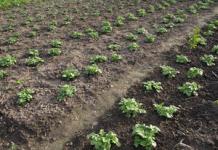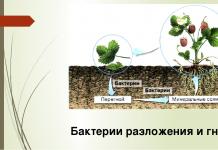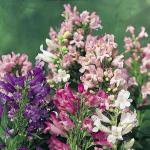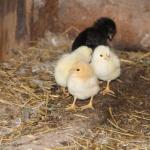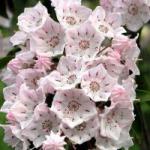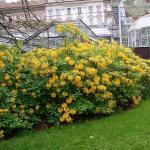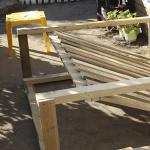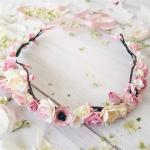Rhododendrons are one of the most beautiful flowering shrubs in our gardens and parks. Deciduous or evergreen - in spring they are completely buried in flowers.
In the people they are called wild rosemary, kashkara, black-maned, shkeri, draposhtan - depending on the type of plant growing in a particular area.
Their genus is very ancient and includes more than 1,000 species, on the basis of which almost 12,000 varieties with a wide variety of useful properties have been obtained. But the main thing is their decorative qualities.
Landing
You can grow rhododendrons in almost any area. Hollows and closed depressions should be avoided, where there is a predisposition to the accumulation and stagnation of surface water, as well as the accumulation of cold air.
The landing site must be protected both from the withering and cold wind, and from bright sunlight. Deciduous species are more resistant and can grow in an open sunny area. For one bush, a landing pit is being prepared; for a group, it is best to prepare a plot of the required area. The size and depth of the planting hole is determined by the soil conditions and the hydrological regime of the site.
Usually the width of the pit is 60-70 cm, the depth is 30-40 cm. On heavy clay soils, the pit should be less deep (15-20 cm) and much wider (1-1.2 m). The planting hole is filled with high-moor peat or soil mixture prepared in advance. It is very important that the pH of the substrate is acidic (3.5-5).
The following mixtures are recommended: acid peat, coniferous and leafy soil, river sand (3:1:2:1); acid peat, sawdust, sand (2:1:1); peat, fallen needles, sawdust, sand (2:1:1:1), etc. It is desirable to add a complete mineral fertilizer to the soil mixture at the rate of 150-200 g / cu. m, as well as 40-60 g of sulfur.

Before planting, the rhododendron in a container or with a clod of earth is placed in a container of water and kept until the clod is completely saturated with moisture. Then they are taken out of the container and planted in a prepared planting hole.
Deepen into the soil so that the upper part of the root ball from the container is at the level of the soil surface. Do not bury the root neck of the plant. If this rule is violated, it ceases to bloom, and eventually dies.
Around the landing site, a small roller is formed from the earth and water is gradually poured until the soil is completely saturated with moisture. After 1-2 weeks, the soil is leveled, but a small depression is left in order to retain water during further watering.

Watering
The usual watering rate is 1-1.5 buckets two to three times a week for an adult plant. Young seedlings are watered more often, but not more than 0.5 buckets per 1 bush. During flowering - more often.
If the weather is dry in autumn, the plants should also be watered abundantly. This contributes to better overwintering. In dry and hot weather, the bushes are sprayed with water.
Water should be acidified before watering: the pH of the water should be no more than 4-5 units, otherwise the soil will become alkaline, and the rhododendrons will start to hurt. Under such conditions, they are deficient in nitrogen, which manifests itself in the form of yellowing of the leaves. Then they dry up and the plant dies.

For acidification, you can use concentrated sulfuric acid (1 ml per bucket of water) or oxalic, citric, acetic or other organic acids (3-4 g per bucket of water).
A good solution to this problem is the use of electrolyte for acid batteries. 10-20 ml of electrolyte per bucket of water lowers the pH from 7 to 4-5 units (electrolyte is the same sulfuric acid, only diluted, and therefore there is practically no risk of getting burned).
Secondly, using an electrolyte, we not only acidify the soil, but also introduce one of the vital elements of mineral nutrition for heathers - sulfur.

The soil near the bushes should not be loosened, since the root system of rhododendrons lies very close to the surface.
Late spring and early autumn frosts are not dangerous for flowers. Most varieties during the period of active vegetation and flowering are able to withstand temperatures down to -7 degrees. Faded inflorescences must be removed. This prevents the formation of seeds, but allows the plant to use nutrients to lay buds for flowering next year and for the growth of shoots.
At a young age, the removal of inflorescences causes the formation of new branches and a better growth of the bush in width and height. Additional branching can be achieved by removing vegetative buds.

The most winter-hardy varieties
Of the evergreens - Album Novum (Album Novum) (Rh. catawbiense) - without shelter withstands frosts down to -29 degrees. Flowers in buds are pink, later pure white with a yellow spot. Blooms later than other varieties. Growth is strong, the bush is spherical, vertically directed.
Rhododendron Katevbinsky Grand diflorum (Rh. catawbiense Grandiflo-rum) - withstands frosts down to -30 degrees without shelter. The flowers are light purple with a delicate bronze pattern. Growth is strong. The bush is spherical, slightly flattened.
Variety Helsinki University (Rh. brachycarpum hybr.) - withstands without shelter frosts down to -40 degrees. The flowers are light pink, inside are lighter with a maroon pattern.

Nova Zembla (Rh. catawbiense) - without shelter withstands frosts down to -29 degrees. The flowers are ruby red. The leaves are large, dark green. Growth is strong, the bush is dense.
Haaga - withstands frosts down to -30 degrees without shelter. The flowers are pink. Bush of medium height, slightly spreading.
Elite (Elite Rh / carolini-anum cv.P. J.M. Elite) - withstands frosts up to -35 degrees without shelter. The flowers are purple-pink, darker inside than on the edge. The bush is spreading. Leaves with rosemary scent. Blooms in late April-early May.
Of the deciduous rhododendrons, almost all varieties winter, but in the fall it is necessary to insulate the root system.
Trimming flowers
In general, pruning is optional, but possible to form a bush. It is carried out immediately after flowering. At the beginning of summer, excess root suckers and long shoots are removed. Cut out dry and damaged branches regularly.
Pruning is best tolerated by fast-growing varieties and forms, but in most it delays growth and the first flowering.

Application in the garden
Any variety can be planted as a single bush on a lawn or under a canopy of trees. Plants will look great in compositions on alpine slides, in "Japanese gardens", in single and group plantings, in hedges, in decorative compositions in gardens, parks, squares, forest parks.
From them you can create beautiful undersized and medium height curbs. They will decorate the heather garden. A flower is also suitable as a groundcover.
They can be planted in various containers near the porch, arbors and benches in the garden. This reduces the need for a substrate by 50-70%, containers can be transferred from one place to another for short-term decoration of a site or a winter garden.
The most suitable varieties of compact Yakushima rhododendron (Rh. yakushimanum), as well as Japanese evergreen species. In large containers it is possible to grow other species and varieties.
A number of varieties are used for industrial cut cultivation. Cut flowers stand in vases for a long time (up to 20 days) without losing their decorative effect.

Useful rhododendron
- Adding petals of Canadian rhododendron to fermenting wine for 20 minutes. completely stops the fermentation process.
- The most important essential oil raw materials are yellow flowers. They are harvested by hand and processed within 2-3 hours. The oil is a light yellow or brown thick mass with a pleasant smell.
- Erikolin and andromedotoxin, which is contained in its leaves, can paralyze insects and small animals. Near the plantings of this plant there will be no mosquitoes, flies and other blood-sucking, as well as small animals: rodents and reptiles.
- Honey collected from the flowers of the Caucasian species has a healing effect and is very useful for colds.
- An infusion of leaves of the golden variety (1 teaspoon per glass of water, 3-4 times a day) is used as a diaphoretic, diuretic and sedative. It is able to reduce venous pressure, reduce edema in patients with circulatory failure, and have an antimicrobial effect. A decoction of the leaves is drunk for tiredness and pain in the legs.
- Wood of the Pontic species is used for carpentry and turning crafts.
). The flowering and condition of the rhododendron in the next season depend on the quality of these actions. It is important for a gardener to know the slightest nuances and rules for the autumn preparation of flowers for hibernation (for more details on preparing a rhododendron in autumn for winter, see).
Reference. The word "rhododendron" in literal translation from Greek means "rose tree" or "tree with roses", but it has nothing to do with a rose. Their connection is only in the beauty of flowering, a wide variety of types and varieties.
In autumn, shrubby pruning is done - one of the mandatory and very important processes. All perennial plant species are exposed to it, rhododendron is no exception.
Types of possible pruning:
- sanitary;
- rejuvenating;
- formative.
You can find out in more detail about whether or not the rhododendron is pruned for the winter.
At the end of autumn, as soon as the first frosts come, rhododendron bushes are tied with a rope and covered with plastic wrap or a bag. This makeshift hut should be removed immediately after the snow melts.
The deciduous species tolerates winter well in temperate climates. Can survive frosts up to 10 degrees without shelter. If the temperature drops below, then you will have to use burlap.
Evergreen varieties of rhododendrons tolerate low temperatures worse. Bushes need extra shelter, as they often break branches under the weight of snow cover or strong winds. It is best to build a small insulation structure above the bush to protect the plant.
Is it possible to plant at this time of the year and when is it right?
The optimal time for planting in the fall is from September to the end of October. In fact, the procedure can be carried out at any time, but only during the growing season of the plant.
It is forbidden to plant during the flowering period and for 2 weeks after it. In autumn, it is important to plant a few weeks before the hard frosts - you need to give the plant time to adapt.
Which way to choose to plant a plant?
The choice of method depends on the features of the chosen type.
On a note. Wild rhododendrons are propagated vegetatively or obtained from seeds. Varietal - These are complex hybrids for which only vegetative options are appropriate.
The main methods of reproduction and planting:
- Sowing seeds, growing seedlings and further growing in containers.
- Planting cuttings.
- Disembarkation of cuttings.
- Division of the bush (suitable for old and growing bushes).
Step-by-step instructions on how to carry out cuttings
The presented algorithm of actions is suitable for deciduous species. Reproduction occurs by cuttings.
Required inventory
For planting, boxes or boxes will be required. If it is necessary to accelerate growth, then cuttings can be planted in greenhouses or greenhouses. Also planted in open ground, but regular watering, growth control and compliance with suitable conditions will be more difficult to carry out.
Place
Rhododendrons are quite whimsical plants. They are not suitable for planting in dry and cold climates. They love shady places, coolness and water, but they can calmly bloom with constant sunlight. The best place to land is the northern, shady zone of the site. The soil should be loose, filled with humus.
Plants thrive best near water bodies with moist air. If there is no water nearby, the bushes should be sprayed once a week before flowering. For the plant, it is recommended to choose the right neighbors.
Do not plant bushes next to trees such as:
- Linden;
- chestnut;
- maple.
The root systems of these trees are at approximately the same depth and can take all the nutrition from the new plant.
Note! The best neighborhood option is apple, pear, coniferous trees.
preparing the ground
For cuttings, special ready-made acidic earth mixtures or self-prepared soil mixtures are used. The plant is suitable for a mixture of peat, coniferous soil and sand in equal proportions.
Process
Rhododendrons have a fibrous root system. Plants easily tolerate planting, but die when flooded. When planting cuttings, you need to make a shallow hole so that they grow at soil level and do not deepen after the soil has settled. If underwater waters lie close to the site (the level is less than 1 m), good drainage should be made in the landing pit.
Harvesting seedlings for planting is best done in the second half of July. To do this, cut the leaves from the shoots along with the axillary bud and wood in the form of a shield with parallel edges of small length. For deciduous species (azaleas), it is better to choose apical cuttings. If there are many flowers on the bush, then they need to be cut off so that all the forces of the plant are directed to rooting growth, and not to its flowering.
 From the cuttings that are cut, it is necessary to remove the lower leaves, leaving a couple of upper leaves. It is not necessary to shorten the remaining leaves on the cuttings. The cut is made at an angle of 45 degrees.
From the cuttings that are cut, it is necessary to remove the lower leaves, leaving a couple of upper leaves. It is not necessary to shorten the remaining leaves on the cuttings. The cut is made at an angle of 45 degrees.
There is also a pre-treatment of cuttings:
- Soaked in growth stimulants. It is necessary to lower the lower sections into the rooting solution for about a day.
- Containers are filled with soil and leveled.
- Leaf cuttings take root within 5 months.
First watering
The first time you need to water the plant after planting for 3-5 days. Wherein it is important not to flood the roots, moisture should not stagnate. Further watering schedule: once a week.
Outdoor care
What is important for a gardener to consider:
- It is forbidden to loosen the soil near the rhododendron bush. This is due to the fact that the roots of the plant are close enough to the surface. Pulling weeds is better by hand without the use of garden tools.
- In dry autumn, the flower requires abundant watering (an average of 10 liters of water). In a rainy autumn, you can forget about watering.
- You need to water the bushes with soft water (rain or settled). The frequency of watering can be determined by the leaves. If they become dull and begin to lose elasticity, then it's time to start watering. Moistening of the soil should take place to a depth of 30 cm.
- You can not fill the roots of rhododendrons with water. This plant is very sensitive to oversaturation with water in the roots, so they react in the same way as they do to drought (wither).
- In November, each bush begins to be insulated, laying a layer of peat next to it.
Difficulties and problems
Common problems include drying out of the kidneys and stunting. You can correct the situation by daily watering with warm water with growth stimulants. The presence of grass, hay, straw or other mulch that was previously used on the site can adversely affect the condition of the bush. Also, these materials can become a source of pest infestation.
Breeders have bred many varieties and types of rhododendrons. They live long, bloom up to several months a year. They are often used to design flower beds, in the field of landscape design. A flowering bush pleases the owners and brings aesthetic pleasure. Proper care, timely control of diseases and pests is a guarantee of the health and beauty of the shrub.
If you find an error, please highlight a piece of text and click Ctrl+Enter.
We tell you how to transplant and plant a rhododendron in open ground. We describe favorable planting conditions: place, soil, acidity, and give step-by-step instructions.
Proper planting of rhododendron: place, soil
The further growth and development of the plant depends on the correct choice of the planting site, soil and preparation of the soil substrate. It is advisable to decide on a place before buying a seedling so that it immediately gets into comfortable conditions and takes root faster.
Which landing site to choose?
When choosing a site, it is important to take into account the biological characteristics of the species. Ideally, the illumination, humidity of air and soil should correspond as much as possible to the place where it grows in nature. In general, the larger the leaves, the less wind required and the higher the humidity.
- Favorable place - light penumbra from tall trees. At the same time, the "rose tree" needs to be provided with shade at the peak of solar activity - from 11.00 to 16.00, and in the morning and evening it should receive a sufficient amount of light.
Scattered shade is the best conditions for the development of all plant species, especially where there is a sharply continental climate with cold winters, hot summers and low air humidity.
It is better to plant on the north or east side, since the rhododendron is shade-tolerant, and tolerates shade more easily than bright sunlight.
At the same time, some deciduous species (Daurian, yellow, Kamchatka, Canadian or Japanese) can be planted in an open sunny place. However, they will grow better in a shady area with diffused light and bloom more beautifully.
A bad place is a site open to strong winds and the midday sun. In this case, there are often problems with flowering, development and wintering.
It is not recommended to plant in areas with a high level of groundwater, as well as those flooded with melt water in spring. In extreme cases, you can plant on a high ridge (10-15 cm), make good drainage and diversion ditches.
If for some reason you planted a rhododendron in an unfavorable place, then it can be transplanted. The shrub tolerates the transplant well, it often affects it positively. Therefore, you always have a second attempt in reserve.
Selection of neighbors and landing distance
When choosing a landing site, consider the surrounding "rose tree" plants. Since the flower has a superficial root system, the “neighbors” have a pivotal one so that it has enough nutrients.
Best neighbors: spruce, larch and pine - just like in nature.
Good neighbors: pear, oak, pine, apple, cherry.
Bad neighbors: elm, birch, willow, chestnut, maple, linden.
- The minimum distance to large shrubs and trees: 2-3 meters, from the building up to 7 years (then almost no lime is released from the solution) - 1.5 meters. When landing in a row - 130-180 cm.
Soil and acidity
Optimal soil acidity for rhododendron, pH: 3.0-4.5, he loves acidic soils. Therefore, peat soil is excellent. The earth should be rich in humus, with high air and moisture permeability (loose).
Large-flowered species are more sensitive to soil acidity, even a neutral environment inhibits their development.
Soil mix for planting
Main components: moorland, acidic high-moor peat, hardwood (humus) and pine needles. They do not have to be all present, the main thing is to approximately observe the proportion: 50/50 organic part and garden soil from digging a hole.
In light and medium loam, ordinary garden soil, it is better to increase the proportion of peat and add pine needles. In sandy soil, increase part of the loam, peat and humus.
- Horse peat, garden soil (loam or sod land) and sand 3:2:1. A simple blend that has been proven over the years and by thousands of gardeners.
- High-moor peat, leafy soil and coniferous litter, sand - 3:2:1:1.
Any soil mixture must be supplemented with complex mineral fertilizer - 30-40 gr.
Rules and Tips
- Loam or garden soil should make up 35-50% of the volume of any potting mix. So that the substrate is sufficiently loose and permeable to moisture, and also better retains moisture near the roots.
When planted in a soil mixture with a large amount of peat without loam, the water evaporates quickly and after the root ball dries, it is difficult to moisten it due to the air cushion. - Usually, 4-6 standard buckets of high-moor peat and 3-4 buckets of loam are required to prepare the soil mixture. But if you lack any component, then it is better to make a smaller planting hole (30 * 40 cm) than to reduce the amount of peat or loam.
And after 2-3 years, dig a ditch 10-15 cm wide / 30-35 cm deep along the perimeter of the planting pit, and fill it with soil mixture. - Do not add leaves, manure (in any form), grassroots peat, sawdust and black soil to the soil mixture.
Instructions for planting rhododendron
- Dig a planting hole: depth - 31-41, and width - 55-75 cm (deeper and wider than the root ball twice). The dimensions are due to the fact that the root system grows more in breadth than in depth.
- At the bottom, make a drainage layer - 8-10 cm from broken brick (only red), crushed granite, sand, pebbles or fine gravel.
- When planting a seedling, water it abundantly, and if the container is with a dry earthy clod, then soak it for 60-150 minutes (until air bubbles stop coming out) in water to saturate with moisture.
Soaking before planting the root ball of a rhododendron seedling
- Try on the seedling in the hole (neck at ground level) and pour in the potting mix. Remove the seedling and water the hole with 5-6 liters of water to settle the soil and soak the bottom layer to increase survival.
- Position the seedling at the desired depth - the root collar should be at ground level (just like it was in the container). But due to the fact that the substrate will sag, you need to raise it when landing by 3-5 cm.
If planted higher, the bush will freeze more in winter and overheat in summer, and if it is too low, it will begin to rot and bloom poorly. On top and sides, gradually pour and compact the soil mixture so as not to leave an air cushion.
Planting depth of a rhododendron seedling
- Pour a 30-40 cm seedling with 6-8 liters, and a 60-90 cm seedling with 10-12 liters of water into the near-stem circle so that the soil is moistened 20-25 cm deep. In case of strong subsidence of the earth, add the substrate.
- Without fail, pour a 6-8 cm layer of mulch from peat, pine needles, heather or birch, oak or linden leaves on top to retain moisture, increase acidity and increase the amount of humus.
But do not fall asleep at the very base of the flower (root collar), so as not to provoke the bark to rot in winter. It is better to sprinkle it with coarse sand to prevent rot from standing water. - Darken the seedling for 7-12 days, depending on the weather, with a newspaper cap or cloth.
- When planting one copy, make a support for the first 2-3 months so that the wind does not sway it. The stake must be driven into the ground at an angle, towards the prevailing winds, and a seedling must be tied to it.
Rules and Tips
- It is better to dig a landing hole and fill it with soil mixture in advance. If you plant in the spring, then in the fall, and if in the fall, then 2-3 months before planting.
- Plant rhododendron better in cloudy and wet weather.
- When planting a seedling in a container, you need to carefully cut off the outer roots (“felt”), which have died due to prolonged contact with the walls of the container. Otherwise, it will be difficult for young roots to break through their layer to the soil.
You can make 3-4 cuts across the root ball, and then straighten the roots down and to the sides. It is not necessary to completely destroy the com! At the same time, many flower growers note that there is no difference, and you can plant a whole lump from the container without manipulation. - 2-3-year-old seedlings are best planted in a quiet and shady place so that they do not suffer from moisture deficiency. The width of the pit is 30 cm, and the depth is 20-25 cm. For the 4-6th year, transplant the bush to a permanent place according to the basic instructions. This method is especially important to apply if the permanent place will be located in a windy and sunny area of \u200b\u200bthe garden.
- If a bush planted in a permanent place has buds, then it is better to remove them (except for 2-3 pieces to evaluate beauty) so that it takes root better.
Care after planting a rhododendron
In the first year after planting or transplanting, the seedling needs regular watering. It is especially important to water and spray frequently in the heat from April to August, because the seedling has a small root ball and dries quickly.
Every 2-3 days, water with 4-6 liters of water, and it is advisable to spray every day.
There is no urgent need for top dressing, timely watering is much more important, but it is advisable to apply a complex mineral fertilizer after rooting (15-20 days after planting). Use 30% of the recommended doses for an adult plant.
The compositions of dressings are given in the article on plant care - see the bottom of the page.
In autumn, be sure to mulch and cover for the winter with spruce branches or covering material (lutrasil, agrofibre). Drive stakes around the perimeter of the bush and wrap around them.
When is the best time to plant a rhododendron? Spring or autumn?
Experts believe that it is optimal to plant a "rose tree" in spring (April - mid-May) and autumn (September - mid-November). At the same time, a categorical ban on planting and transplanting only for the flowering period and two weeks after it.
In the Moscow region, Siberia, the Middle lane, the Leningrad region and the Urals (cold winters), it is better to plant rhododendron in the spring so that the plant adapts and successfully overwinter by autumn.
Deciduous species are also best planted in the spring before flowering and leafing out, since "autumn" seedlings often die in the first winter.
Rhododendron transplant in spring and autumn
The plant tolerates transplanting well. The main reason for it is the annual unsatisfactory condition of the bush: the absence or weak flowering, poor wintering (severe freezing).
Often the reason lies in an unsuccessful landing site and with the help of a transplant it is easy to breathe a “second life” into the rhododendron. Since transplanting to a new, more suitable place, it gives it strength for growth and flowering.
Rhododendron transplant: timing
It is better to replant the "rose tree" in early spring (late March - early April) or late summer and early autumn (mid-August - October). When the weather is cool and the humidity is high.
In general, the main thing is that the earth can be dug, it was not very wet (liquid mud) and the bush did not bloom.
Some flower growers prefer to transplant two weeks after flowering (June).
Instructions for transplanting rhododendron
- If the soil is dry, then water the small bush abundantly so that the clod of earth does not crumble. It is better not to water the old bush, as it will be difficult to get and carry.
- Mark the branches of the plant in the cardinal directions: north - south or west - east, so that later the bush can be placed correctly in a new place. A similar orientation to the sun will help the plant settle in and take root faster.
- Start digging into the soil with your forks. Since the root system grows more in breadth than in depth and is located close to the surface (20-30 cm), then dig carefully.
Depending on the age (height) of the specimen, make the necessary indent from the base of the bush: 4-5 year old bush - 50-60 cm, old bushes - 80-100 cm.
We give approximate figures with a small margin, since in order to prevent damage to the root system, it is better to retreat more than less. - Carefully remove the bush with a clod of earth. Evaluate the root system, if there are old or rotten roots, then cut them off, and sprinkle the cuts with charcoal powder and preferably treat with a fungicide.
- Then transfer (transport on a wheelbarrow) a bush to a pre-prepared landing pit. Next, transplant the rhododendron with a clod of earth according to the instructions for planting.
Adviсe
There is an opinion that in order to obtain a more symmetrical shape of the bush, it is necessary to plant the less developed side facing the sun - to the south. We do not recommend changing the orientation of the flower - this will create unnecessary stress and complicate adaptation.
5.We wish you successful planting and transplanting, let the “rose tree” grow beautiful and healthy!
Rhododendron is a typical shrub for acidic soils. This plant belongs to the Heather family and is one of the most beautifully flowering. Many summer residents want to grow rhododendron on the site, but this plant cannot be called unpretentious. Rhododendrons love warmth. To take root in the middle lane, they need proper agricultural technology and good care.
In the climatic conditions of the middle lane, about ten proven plant species can be grown. All of them have high winter hardiness.
- sand - 2 parts;
- sod land - 1 part;
- sour peat - 3 parts.
Show all
Description
There are several hundred species of rhododendrons, which are plants of various sizes and shapes - from creeping to tall. There are deciduous and evergreen rhododendrons. In nature, they grow in the mountain forests of the Caucasus, Carpathians, Sayan. The homeland for many species is the Far East, including Kamchatka and the Kuriles. A huge variety of species of rhododendrons is represented in China and India.
The mountain slopes covered with flowering thickets are an unforgettable sight. All species have large flowers, which are even more noticeable due to the fact that they are collected in inflorescences with a bright and clean color.
Rhododendron or Azalea?
Often rhododendrons are called azaleas. Both of these plants belong to the Heather family and are part of the genus Rhododendron. The difference is that indoor deciduous rhododendrons are called azaleas. There are azaleas that keep their leaves all year round - Japanese. They should not be confused with Japanese rhododendrons.
Japanese azaleas are bushes 30-60 cm high, blooming in white, purple, pink and red flowers. Even the most hardy azaleas cannot grow in a northern garden, but they are suitable indoor plants. At home, azaleas bloom in winter, when the rest of the houseplants are at rest, gaining strength in anticipation of spring.
Indoor azalea cannot be called an unpretentious flower. In nature, azaleas grow high in the mountains, on the border of alpine meadows and glaciers, so they are not afraid of the cold. In a hot and dry room atmosphere, the plant quickly dies. Azalea loves diffused lighting and watering with soft water acidified with lemon juice.
Azalea sheds leaves due to the slightest violation of the conditions of detention: when the substrate is dry, high temperature, low humidity and in bright sun. Watering with hard tap water causes the leaves to turn brown. After flowering, the plant must be transplanted, trying not to destroy the earthen ball, and put in a cool place with a temperature not higher than +17 degrees. From October to December, the azalea is kept at a temperature of + 6 + 10 degrees - this is necessary for laying flower buds.
Indoor Japanese azalea shaped like a bonsai

Landing
Rhododendrons grow slowly. Like all slow growing plants, they are long-lived. An acidic soil with a pH of 4-5 is required for successful cultivation. In more alkaline soil, plants turn yellow, shed their leaves, and die quickly.
The most suitable soil for rhododendrons is peat or heather. The bushes will thrive in any soil, even dense clay soil, as long as it is well drained and the right soil mix is made by mixing acidic peat, coniferous soil and sand.
Universal soil mixture for growing various types of rhododendrons:
In no case should lime be added to the planting pit. Plants do not tolerate chlorine, so tap water should not be used for irrigation.

Care
Rhododendrons bloom in spring. Taking care of them in the garden is easy. After flowering, the bushes need top dressing with liquid manure and a solution of any complex mineral fertilizer in a low concentration. In the dry season, the soil around the stems is covered with crushed peat or rotted manure. The roots of the bushes are located superficially, so you need to loosen the soil very carefully.
Most rhododendrons prefer to live in partial shade and do well next to tall, but not very dense trees. The ideal place for them is next to coniferous plants against the backdrop of a lawn.
Rhododendrons grow well in the shade of trees.
reproduction
Rhododendrons are propagated by layering, seeds and cuttings. Small seeds are sown in a greenhouse with peat soil. They are not buried, but simply scattered on wet ground and covered with a film. Shoots can be expected in three to four weeks. Seedlings dive annually, and in the third year they are transplanted to a permanent place.
Propagation by cuttings begins in July. Planting material is cut from the shoots of the current year. Twigs are suitable in a semi-woody state. The apical buds are removed from the shoots. The remaining leaves are reduced by a third to reduce evaporation. Each cutting should have a pair of dormant buds and several leaf blades (up to 6 pieces). The bark is removed from the lower part of the cutting, leaving a greenish cambium, and the exposed area is treated with a growth stimulator - heteroauxin powder.
Cuttings are planted in planting holes made in an acidic substrate made from rotted sawdust or composted bark. Coarse river sand is poured on top and watered abundantly. After planting, the cuttings are shaded by covering the dive box with a film. The box is installed in the greenhouse and make sure that on hot days the cuttings do not "suffocate".
After 3-4 weeks, signs of rooting appear. Rooted cuttings are left to winter in the greenhouse, making sure that the temperature does not fall below zero. If the overwintered seedlings bloom in spring, the inflorescences should be removed. In June, cuttings can be planted in beds, prepared in the open field in autumn, in acidic, loose soil.
Types of rhododendrons suitable for the climate of the middle lane
Plants have been grown in gardens since the 18th century. Since rhododendrons grow in a humid climate in their homeland, the first cultural plantings appeared in countries with similar natural conditions: in England, France, Germany, and the Baltic states. But this does not mean that gardeners in the middle lane can put an end to this culture. Modern varieties grow successfully in continental climates. Several dozen species of rhododendrons are grown in the Botanical Garden of Moscow State University. Their culture is complex, but the extraordinary exotic beauty of the southern plant will reward gardeners for their care.
In cold climates, about ten species of rhododendrons can be grown. All of them have high winter hardiness and tolerate the cold climate of the middle zone.
Yellow, or Caucasian
In nature, it grows in the Caucasus and throughout the south-west of the European part. This is the most common species in European gardens. The Caucasian rhododendron is a small shrub with dense branches. Plant height - up to one and a half meters. The leaves are large, oblong, up to 10 cm long. The edges of the pointed leaf plates are decorated with small cilia.
The plant is beautiful not only during flowering, but also in autumn, when the leaves, previously green, turn purple and red. Leaf fall comes late - in October. The shrub blooms from the age of five. Flowering lasts 25 days, falls on the first half of June.
The yellow rhododendron has large flowers collected in inflorescences-caps. Each 5 cm in diameter, funnel-shaped corollas with a narrow tube, yellow petals with orange dots. They are very fragrant - oil is obtained from them, which is used in the manufacture of perfumes. Plants are planted in groups under the canopy of trees.
The yellow rhododendron reproduces easily and quickly - by root offspring, which allows it to be used on slopes to fix the soil. Transplantation of offspring is possible in the fall, after leaf fall. The plant is poisonous: even the honey from its flowers is believed to have toxic properties.
Rhododendron yellow
Ledebour
The plant is native to Siberia. Natural habitat - Altai and the Republic of Tuva. Ledebour's rhododendron is an adornment of the subalpine belt. It forms extensive thickets under the canopy of deciduous and cedar forests.
The plant is an evergreen shrub with dense branches and abundant foliage. Leaf plates are oval, up to 3 cm long, olive in color, bright yellow in summer, purple in autumn. Leaves live 1-2 years and then fall off. New ones are being deployed in their place. In the heat and winter, when the plants do not have enough moisture, the leaf plates are folded into a tube.
Against the background of green leaves, purple-pink flowers located at the ends of the branches look luxurious. The diameter of each flower is up to 5 cm. The plant blooms profusely every year from the age of three. On the site, it will become one of the earliest flowering. Rhododendrons of Ledebour are planted in groups under birches, pines and in open places.
Dahurian
In nature, the Dahurian rhododendron grows in the south of Eastern Siberia and the Far East. The plant feels good under the canopy of pines and other sparse conifers. It is close in requirements to Ledebour's rhododendron, from which it differs in lighter and smaller flowers. The color of the petals is predominantly pink. Muscovites know Daurian rhododendron as heather. Its bare twigs are brought to the capital in spring and sold in flower stalls. If a branch is placed in water, it will bloom very soon.
In nature, it is a deciduous shrub up to 2 meters high with small elliptical leaves and pink flowers up to 4 cm in diameter. There are varieties with white flowers.
Dahurian rhododendron blooms in April and blooms before the leaves bloom. The plant tolerates frosts down to -32 degrees, but can be captured by spring frosts, and then the flowers will fall off. It does not need acidic soil - just add a little high-moor peat to ordinary garden soil.
Dahurian rhododendron
Japanese
Reminiscent of yellow rhododendron, but comes from Japan. The plant does not like shading, preferring sunny open areas.
The Japanese rhododendron was introduced into culture in the nineteenth century, but in our country it is still grown only in botanical gardens and is very rare among amateurs. Although the plant is unpretentious, winter-hardy and has excellent decorative qualities. It has large green leaves with cilia along the edge. In autumn they turn dark red or bright yellow. This beautiful rhododendron blooms profusely and annually from the age of 3 with rare salmon-red flowers for these plants. The diameter of the corolla is up to 5 cm. The flowers are collected in inflorescences at the ends of the branches, they have a pleasant aroma.
Japanese rhododendron does not need acidic soil. It can grow in ordinary garden soil diluted with peat. Plants propagate by seeds and summer cuttings. Rooting cuttings reaches 33%. For the winter, the roots of the bushes are covered with leaves, raking them with a layer of 20-30 cm. The aerial part can not be insulated.
Canadian
Deciduous shrub up to 80 cm high, blooming already in April with purple-violet or white flowers 3-4 cm in diameter. Flowers bloom earlier than leaves.
Canadian rhododendron is one of the ten most unpretentious flowering shrubs and is quite capable of growing in the middle lane.
Katevbinsky
Evergreen shrub up to 2 meters high with elliptical long green leaves. The plant is demanding on the acidity of the soil and does not like the open sun. It blooms in May with lilac or purple flowers collected in hats of 20 pieces. Flowering continues until June, lasts about a month.
The Katevbinsky rhododendron has many hybrid varieties obtained from crossing with other evergreen rhododendrons.
Yakushimansky
A small spherical bush with a diameter of up to one and a half meters and a height of not more than a meter. It grows slowly, but blooms profusely and for a long time. Flowers bloom throughout May and even early June. Petals pale pink, then turn white. Corolla diameter up to 6 centimeters. Flowers are collected in inflorescences of 10 pieces.
Plants are photophilous, winter-hardy, withstand frosts down to -26 degrees. It is better to cover young bushes for the winter with pine or spruce branches. Yakushimansky rhododendron is suitable for rock gardens and group plantings.
Impedium, or dense
Evergreen shrub with large purple flowers. Its homeland is China, where it grows at an altitude of 3,000 m above sea level. The height of the plant is only 1 m, during the year the branches lengthen by 1-3 cm. The impeditum resembles a dense pillow. Perfectly adapted to the conditions of central Russia and blooms in the second year after sowing seeds. This is a champion in winter hardiness and decorative qualities. There are white-flowered and pink-flowered varieties.
– This is a charming ornamental plant for your garden. But it is not easy to grow in our area. The homeland of this flower is the Mediterranean, which indicates its thermophilicity, and poor frost tolerance. Therefore, in order for the plant to take root, it will be necessary to observe all the conditions for proper agricultural technology and provide it with proper care. Today we’ll talk about how to choose the right seedlings for planting rhododendron on your site, about the features of this process, and also pay attention to the subsequent care and preparation of rhododendron for winter. In addition, information regarding its application in landscape design will be no less useful.
The right choice of planting material
Two- or four-year-old rhododendron bushes are best suited for planting. When buying, pay attention to the bushiness of the cuttings of the seedling (the most tenacious ones branch immediately near the root neck), and to its leaves (should be free of spots and swellings). Also, be sure to inspect the roots of the seedling, it is unacceptable that they have wet blotches and knots. The place where you buy seedlings is also important.
 It is best to buy them in experienced gardeners or special nurseries, and not desirable - in the markets, since they have much less chances (most sellers simply do not know what varieties and types they sell).
It is best to buy them in experienced gardeners or special nurseries, and not desirable - in the markets, since they have much less chances (most sellers simply do not know what varieties and types they sell).
Important!Beginners are advised to start not with a specific variety of rhododendron, but with planting the species. Since the species is less whimsical, and more frost-resistant than the variety obtained on its basis. Despite the fact that the varieties are very tempting with their wide variety of shades, the species also stand out for their variety of colors.
Planting rhododendron in the garden
When planting a rhododendron in the garden, certain guidelines must be followed when and where to plant a rhododendron, how to do it correctly, and how to prepare the soil.
Did you know?The tree rhododendron is the national flower of Nepal. In this country, rhododendron is consumed in the form of pickled flowers, and in the form of juice.
When to plant rhododendron
It is recommended to plant rhododendron in the ground from early April to mid-May, and from September to November. But in fact, this can be done at any time during the growing season of the plant, in addition to the flowering period of the rhododendron, and a couple of weeks after flowering.
Where is the best place to plant a rhododendron on the site
 It is better to plant rhododendron in a shady place, on the north side of the house. The soil should be loose, acidic, well-drained, rich in humus. When the groundwater in your area lies at a depth of less than one meter, then the plant is planted on a raised bed. When planting a rhododendron, it is also important to pay attention to neighboring plants.
It is better to plant rhododendron in a shady place, on the north side of the house. The soil should be loose, acidic, well-drained, rich in humus. When the groundwater in your area lies at a depth of less than one meter, then the plant is planted on a raised bed. When planting a rhododendron, it is also important to pay attention to neighboring plants.
It is undesirable to plant rhododendron close to trees that have a superficial root system, because they will take all the nutrients from the plant. Birch, willow, maple, chestnut, linden, alder should also be attributed to undesirable neighbors, and apple trees, pears, pines, spruces, larches, and poplars belong to the inhabitants of the site near which rhododendron can be planted.
How to prepare the soil and plant a rhododendron
- First of all, prepare a hole for planting. The pit is dug about 40 cm deep and about 60 cm in diameter.
- Then prepare a mixture of eight buckets of high-moor peat and three and a half buckets of loam (loam can be replaced with two buckets of clay). Mix this mixture thoroughly, pour into the pit, and tamp well.
- After that, dig a hole in the soil the same size as the root of the seedling.
- Before planting directly, put rhododendron seedlings in water, and hold them there until air bubbles stop emitting.
- Place the seedling in the hole and fill the hole with substrate to the very top so that the root neck is at the level of the surface of the site, tamping it down to eliminate all voids.
- Water the plant generously, and mulch the soil around the trunk with peat, moss, sawdust, oak leaves, or pine needles, in a layer of about 5-6 cm.
Important!If there are many flower buds on the seedling, then it is better to remove them so that all the forces of the plant are directed to the rooting of the rhododendron, and not to its flowering.
The combination of rhododendron with other plants and use in landscape design
 Rhododendron will find its place in landscape design of almost any style. The plant looks excellent in the role of a tapeworm, and in group compositions, and in the latter case it is perfectly combined with conifers, and with other types of flowering plants. It is best to select species with which rhododendron grows in its natural environment - pines, larches, ferns, junipers, and others.
Rhododendron will find its place in landscape design of almost any style. The plant looks excellent in the role of a tapeworm, and in group compositions, and in the latter case it is perfectly combined with conifers, and with other types of flowering plants. It is best to select species with which rhododendron grows in its natural environment - pines, larches, ferns, junipers, and others.
Rhododendron is perfect for decorating rocky gardens and alpine slides. For this, low-growing types of rhododendron with different flowering periods are suitable. You can compose them, decorating rocky slopes, with gentian, mountain pine, and heather.
Medium-sized species of rhododendron are often used in group plantings in the form of living fences, with the selection of the desired shades of the plant. For example, rhododendrons with yellow flowers go well with those shrubs that bloom with red and bright orange flowers, and rhododendrons with purple and pink flowers with plants that bloom in white.
Shrubs planted on the lawn or along garden paths and borders look good, especially when decorating the parterre lawn, although in this case only mature rhododendron shrubs (at least ten years old) are suitable.
 When creating group compositions with rhododendrons, it is recommended to combine evergreen species with deciduous ones, while correctly "mixing" plants of different heights. Tall shrubs look better in the center of the composition, and undersized ones along the edges.
When creating group compositions with rhododendrons, it is recommended to combine evergreen species with deciduous ones, while correctly "mixing" plants of different heights. Tall shrubs look better in the center of the composition, and undersized ones along the edges.
Proper care of rhododendron in the garden
Caring for a rhododendron consists of the usual procedures for plants: feeding, watering, spraying, weeding, pest and disease control, bush formation.
Important!Loosening the soil around the plant is prohibited, and even more so digging it up, since the roots of the rhododendron are placed too close to the surface. For the same reason, weeds are best removed by hand, without using choppers.
How to water
Rhododendron requires atmospheric and soil moisture more than other plants, especially when buds are formed and during flowering. You need to water it regularly, and in dry weather you should also spray the plants with water. Proper watering also affects the laying of flower buds of next year's rhododendron. Water the plant with soft water(settled, thawed, or rain), which can be softened with a handful of high-moor peat thrown a day before watering.
 The frequency of fluid application is determined by the condition of the leaves: for example, when they are dull and have lost their elasticity, then the plant is thirsty. When watering, the soil should get wet to a depth of 20-30 cm.
The frequency of fluid application is determined by the condition of the leaves: for example, when they are dull and have lost their elasticity, then the plant is thirsty. When watering, the soil should get wet to a depth of 20-30 cm.
Important!When watering, you can not pour the roots of rhododendron, because they are very sensitive to excess moisture. You can learn about an excess of fluid by lowered and curled leaves.
How to feed a plant
The first dressing of rhododendron takes place in early spring, and the last - at the end of July, at the end of the flowering period, when young shoots begin to grow. You can use semi-rotted cow dung and horn meal to feed the plant. Rhododendron prefers liquid top dressing, so the manure is poured with water (ratio 1:15), and left to brew for a couple of days. Before you apply fertilizer for rhododendron, it should be watered.
If we talk about mineral fertilizers, then in order not to disturb the reaction of the environment (rhododendron grows in acidic soils), it is best to use superphosphate, ammonium sulfate, low concentration magnesium (1.2: 1000), and an even weaker solution of potash fertilizers.
 The optimal feeding regime involves the introduction of organic or mineral nitrogen-containing fertilizers at the rate of fifty grams of magnesium sulfate and fifty grams of ammonium sulfate per square meter (fertilizers are applied to the soil in early spring), and at the end of the flowering period (in early June) - per square meter should account for forty grams of ammonium sulfate and twenty grams of potassium sulfate and superphosphate. In July, only twenty grams of potassium sulfate and superphosphate are added per square meter.
The optimal feeding regime involves the introduction of organic or mineral nitrogen-containing fertilizers at the rate of fifty grams of magnesium sulfate and fifty grams of ammonium sulfate per square meter (fertilizers are applied to the soil in early spring), and at the end of the flowering period (in early June) - per square meter should account for forty grams of ammonium sulfate and twenty grams of potassium sulfate and superphosphate. In July, only twenty grams of potassium sulfate and superphosphate are added per square meter.
Did you know?Honey from the nectar of some species of rhododendron has hallucinogenic and laxative properties. Even the ancient Romans and Greeks talked about the side effects of rhododendron honey.
How to prune a rhododendron
Rhododendron requires minimal shaping and pruning, as its bushes form the correct shape by themselves. However, from time to time it will be necessary to cut too high, frozen or old shoots, which will help rejuvenate the rhododendron. Prune rhododendron shoots in early spring, and the places of cuts are processed with garden pitch (but only where the thickness of the branches reaches 2-4 cm).
 A month later, dormant buds on the shoots awaken, and a renewal process begins, which lasts for a year. Heavily frozen or very old bushes are cut at a height of 30-40 cm from the ground - one half of the bush in the first year, and the second - in the next.
A month later, dormant buds on the shoots awaken, and a renewal process begins, which lasts for a year. Heavily frozen or very old bushes are cut at a height of 30-40 cm from the ground - one half of the bush in the first year, and the second - in the next.
Important!Rhododendrons have a characteristic feature: in one year they bloom and bear fruit quite generously, and the next year they are already much more modest. To get rid of such periodicity, it is necessary to break off wilted inflorescences immediately after flowering. Then the rhododendron will use its strength and nutrition to form flower buds for the next year.
Preparing for winter and sheltering rhododendron
It is necessary to prepare the rhododendron for winter in advance. To do this, from the end of summer, you should stop feeding the plant with nitrogen, and switch to potash fertilizers (this will help the ripening of late growths). You can also add colloidal sulfur to the soil, which will acidify the soil and slow down the growth of fungi.
Rhododendron bushes can be treated with any of the available fungicides. In dry autumn, the plant should be watered before frost, but in rainy autumn, additional watering is not needed. Evergreen species of rhododendrons especially need moisture.
As soon as serious frosts come, you need to insulate the root zone of the plant. This can be done by mulching with a layer (10-15 cm) of peat, pine needles, or dry leaves. This is done in late autumn. Weak frosts are not very dangerous for the plant, but too early shelter of rhododendron bushes can lead to the decay of the root collar and the death of the plant.
 Now, in fact, with regard to the construction of a shelter for the rhododendron. First you need to make a frame of strong wire, and install it before the ground freezes. Its dimensions should be 15 cm larger than the plant itself, so that the branches of the rhododendron do not touch the arcs.
Now, in fact, with regard to the construction of a shelter for the rhododendron. First you need to make a frame of strong wire, and install it before the ground freezes. Its dimensions should be 15 cm larger than the plant itself, so that the branches of the rhododendron do not touch the arcs.
When the air temperature drops to -10 ° C, the frame should be covered with protective material (polyurethane foam, polypropylene foam), and if the material is not too dense, then it can be folded into several layers (lutrasil, agrotex, spandbond and others). In the event that the coating begins to let moisture through, you will have to stretch the plastic film on top. The material on the frame is firmly fixed, and from below along the entire length it is sprinkled with soil.
There is no need to rush to remove the shelter from the rhododendron as soon as the sun warms up. In March, the plant is still at rest, and cannot independently absorb moisture from the frozen ground, and the leaves of the rhododendron can be burned by the bright rays of the sun. Therefore, you will have to wait until the soil completely thaws and warms up, because only then can you remove the shelter from the rhododendron, and it is advisable to do this on a cloudy day. In the first days after removing the shelter, it is better to shade the plant in order to avoid the harmful effects of the sun.
Did you know? North America is considered the birthplace of the rhododendron, and the large-leaved rhododendron is the state symbol of Washington.
With the right planting and care, this delightful ornamental plant will become an integral part of the composition in your garden.
Was this article helpful?
Thank you for your opinion!
Write in the comments what questions you did not receive an answer to, we will definitely respond!
287
times already
helped
